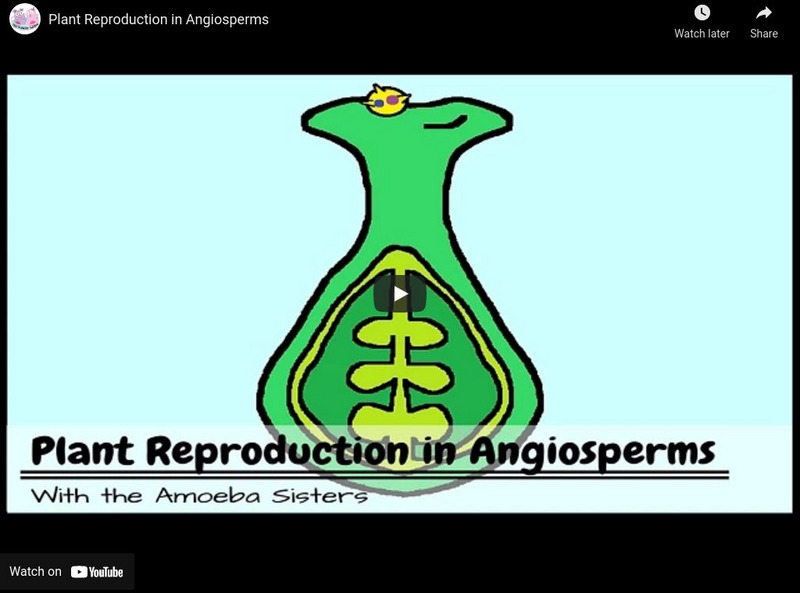Hi, what do you want to do?
Scholastic
Study Jams! Flowers
RJ hangs out in Zoe's garden as she explains pollination, flower anatomy, and fertilization. This cartoon-styled feature is sure to stay in your botanists' minds! Follow it with the dissection of large flowers, such as the lily.
Curated OER
Life Cycle of a Flowering Plant
The development of the male and female gametes in a plant is illustrated, explaining plant fertilization, pollination, and reproduction. Overall, get a complete picture of the life cycle of a flowering plant with some wonderful details...
Curated OER
Plant Reproduction: Asexual Reproduction
Asexual reproduction in plants occurs from bulbs, perennating organs, or even gardening techniques like cuttings. Commercial growers rely on the ability of some plants to reproduce asexually and grow roots rather than starting from...
Crash Course
The Plants and the Bees: Plant Reproduction
This video explains the difference between gametophytes and sporophytes and uses this this information to teach the reproduction process of various vascular plants. Viewers see how ferns, gymnosperms, and angiosperms reproduce.
MinuteEarth
Who Are Flowers Trying to Seduce?
Learn the tricks plants use to attract insects and animals in their quest for pollination. A thorough video lesson describes plant adaptations that meet their reproductive needs. From bees to rodents to bats, the narrator describes how...
Deep Look
This Vibrating Bumblebee Unlocks a Flower's Hidden Treasure
Some plants lock their pollen up until feeling the correct password. The video explains buzz pollination and how it differs from the pollination of other types of flowering plants. It lists multiple plants that require it and...
Amoeba Sisters
Plant Reproduction in Angiosperms
A colony of bees has moved into someone's home and the owners know how important bees are for pollination. Should they keep the bees? An informative video also includes a guide to plant reproduction including the male and...
PBS
How Sex Became a Thing
Birds, bees, flowers, trees ... and Funisia dorothea? Biology scholars journey back in time to discover more about the history of sexual reproduction. The video, one of many in a biology playlist, covers our earliest eukaryotic ancestor,...
Crash Course
The Sex Lives of Nonvascular Plants: Alternation of Generations
Plants evolved more than 400 million years ago into two types — vascular and nonvascular. Here's a video that explains the difference between vascular and nonvascular plants and then focuses on the over 24,000 types of nonvascular...
California Academy of Science
Why Protect Pollinators?
Would you rather having biting flies or chocolate? The question may seem absurd, but cocoa trees rely on pollination from biting flies. Viewers come to understand the importance of pollinators to our food supply, flowers, and entire...
TED-Ed
The Sexual Deception of Orchids
A plant engaged in sexual deception? Strange but true. Believe it or not, orchids have developed a range of sexual adaptations that permit them to attract pollinators. The narrator of a short video describes a variety of strategies used...
Crash Course
Vascular Plants = Winning!
Viewers explore vascular plants with a video that shows their different tissues, their ability to grow taller and wider, and their parts. Young scientists then see these plants xylem and phloem and learn how vascular plants move...
Stated Clearly
What is Evolution?
Learn about the basics of the mechanism of evolution and the importance of natural selection, and examine evidence showing that we are seeing evolution playing out in every organism we encounter. In an engaging and easy-to-follow video,...
Stated Clearly
What is Evolution?
A short video offers a simple, yet engaging, explanation of the theory of evolution using amoebas as an example. The narrator uses the example of the evolution of dog breeds as an example of how humans can influence the course of change.
PBS
Pbs Learning Media: The Reproductive Role of Flowers
In this video segment adapted from NOVA, learn about the critical role of flowers in seed plant reproductive biology. [4:01]
Minute Earth
Minute Earth: Who Are Flowers Trying to Seduce?
In this video, we learn about some of the strategies flowers use to attract pollinators and ensure that they reproduce. [2:18]
Amoeba Sisters
Amoeba Sisters: Plant Reproduction in Angiosperms
This video will show you how flowering plants reproduce. Travel with pollen as it transferred to the ovary so that the egg can be fertilized! Learn how animals and adaptation of the plant allows for the transfer of pollen. Teachers can...
NPR: National Public Radio
Npr Videos: Skunk Bear: The Stink of the Corpse Flower, Explained
This flower smells like rotting flesh - and it's managed to trick a large mammal into spreading its seeds around the globe. [3:41]
PBS
Pbs Learning Media: From Seed to Flower
Watching plants grow is like watching paint dry: It happens so slowly that the changes are imperceptible from one moment to the next -- and yet the end results are dramatic. This video segment shows just how amazing plant development can...
Other popular searches
- Flower Reproduction Diagram
- Labs for Flower Reproduction
- Label Flower Reproduction
- Flower Reproduction Video
- Star Flower Reproduction
- Plants, Flower Reproduction
- Plants Flower Reproduction






















